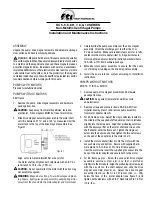
10
pulling A Vacuum
cautIon:
Do not pull a vacuum on the the earth loop until
all of the Grout 111 has cured. Failure to comply
may cause damage to the copper or polyethylene
tubing. consult the installation guide supplied with
the earth loop.
1. The shut off valves on the compressor unit all remain shut,
and the cut-off valve(s) at the end of the liquid line assembly
are opened to the field.
2. Pull a vacuum on the air handler side.
3. Pull a vacuum on the field side.
4. Pull a vacuum on the compressor unit.
notE:
Because of
check valves/reversing valves within the compressor unit that
isolate various segments,
the vacuum on the compressor
unit must be pulled from 3 areas:
a.) The suction line to the compressor. See
for component locations.
b.) The discharge line from the compressor.
c.) And from the very top, front, insulated liquid line, (this
line goes to the air handler from the compressor unit,
but the vacuum must be pulled from the schrader valve
to the left of the sight glass, on the compressor side of
the shut-off valve to the air handler).
• After a 250 micron vacuum (minimum) has been pulled in
the air handler side, immediately insert a 2 lb. holding charge
of R-410A, and replace and tightly secure all schrader valve
caps. Schrader valves are designed to primarily contain
pressurized refrigerant, and, if left without a tightly sealed
cap, will lose a vacuum.
• After a 250 micron vacuum (minimum) has been pulled in
the borehole side, immediately insert a 2 lb. holding charge
of R-410A, and replace and tightly secure all schrader valve
caps.
• After a 250 micron vacuum (minimum) has been pulled in all
three segments of the compressor unit, insert a 3 lb. holding
charge of R-410A. Equally segment the 3 lb. holding charge
among all three segments, and replace and tightly secure
all schrader valve caps. See
EXaMPlE
If a 3 lb. holding charge is used for the entire compressor
unit, place 1 lb. in the suction line to the compressor, place
1 lb. in the discharge line from the compressor, and place 1
lb. in the top, front, insulated liquid line. Replace and tightly
secure all schrader valve caps.
• The remaining balance of the total charge should then be
inserted into the vapor line to the field.
recommended r-410a charging Procedure
After the installed system is evacuated and the electric wiring
is in place, the system is ready to be charged with R-410A
refrigerant. R-410A charging is an important part of the system
installation. Too much refrigerant will flood the accumulator
in heating mode causing the compressor to draw high watts.
Too little refrigerant will freeze the indoor coil in cooling
mode operation.
the recommended charging method is
to charge refrigerant to the middle of the sight glass of
the accumulator during heating operation.
In cooling mode (with correct R-410A charge), the refrigerant
returning from the well is in a saturated condition. The
conventional method of charging by sub-cooling is not
applicable to this system.
The recommended charging procedure includes:
1. Initial charge,
2. Start in heating and charge to the middle of the sight glass,
3. System check.
Initial charge
• When charging the system with R-410A, always turn the
refrigerant bottle upside down so that the liquid refrigerant
feeds from the bottom of the tank.
lists the
recommended initial R-410A charge.
• After the initial R-410A charge is determined, the initial
amount of R-410A can be added to the system in OFF
mode. In order to reduce the chance of over-charging the
system, the initial charge is approximately 0 to 7 lbs. less
than the final required charge. A refrigerant reclaimer/pump
may be necessary.
When adding initial R-410A charge
1. Make sure the system is off.
2. Make sure all 4 service valves inside the compressor unit
are open.
3. Add liquid R-410A to the vapor line charging port until either
the total initial charge is reached or no more refrigerant can
be added to the system.
4. Determine appropriate amount of charge for L1 & L2 line
sets. See NOTES in
5. Add liquid R-410A to the vapor line charging port to the air
handler until the total initial charge is reached.
starting In heating Mode & charging to sight
Glass
If all wiring is properly completed, the system may then be
turned on, as instructed in this manual.
the system may
not engage immediately because of a time delay on the
control board
.
Before starting the system in heating mode, make sure
the home owner is aware of the heating mode operation.
Especially in the summer time, the home temperature may
be uncomfortable during R-410A charging. Close all electrical
disconnects to energize the system.
1. Start the system in heating mode and run for at least 15
minutes.
2. Look at the sight glass on the accumulator. If the float is at
the bottom of the accumulator the system is undercharged.
If the float is on the top of the accumulator, the system is
over charged.
3. If the system in under charged, add liquid R-410A refrigerant
slowly to the charging port on the vapor line, until the float
is in the middle of the sight glass.
lInE
sEts
LINE SET VApor LINE o.D.
3/4”
7/8”
L1
0.86
0.96
L2
1.07
1.17
Adjustments in oz per ft if L1 or L2 do not equal the default values in Table
4 (page 9).
table 5. line set adjustments






































